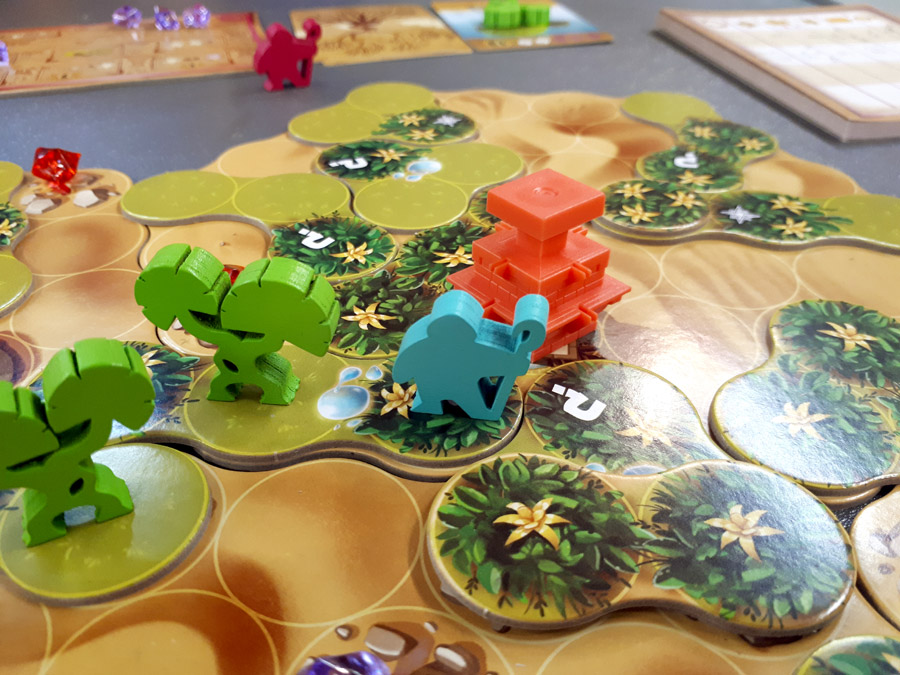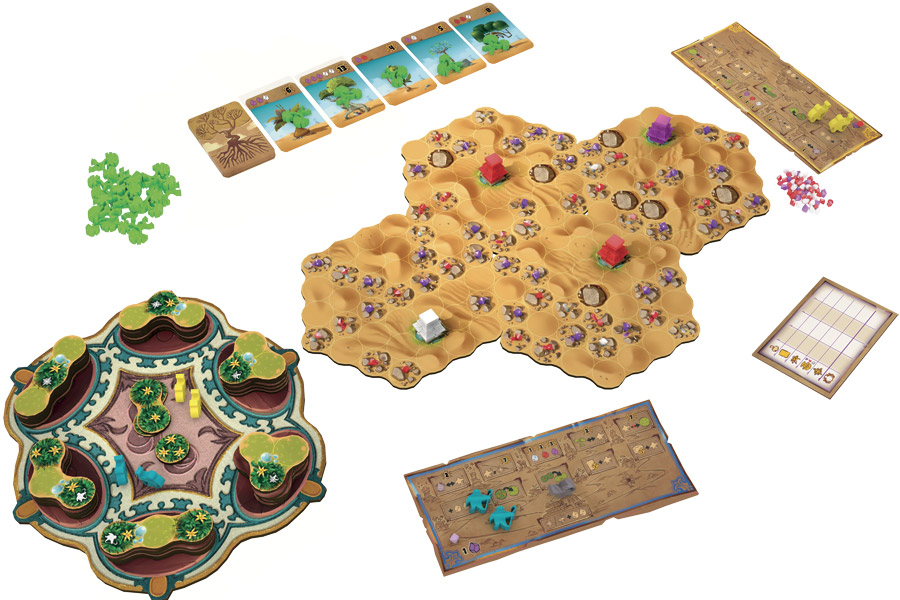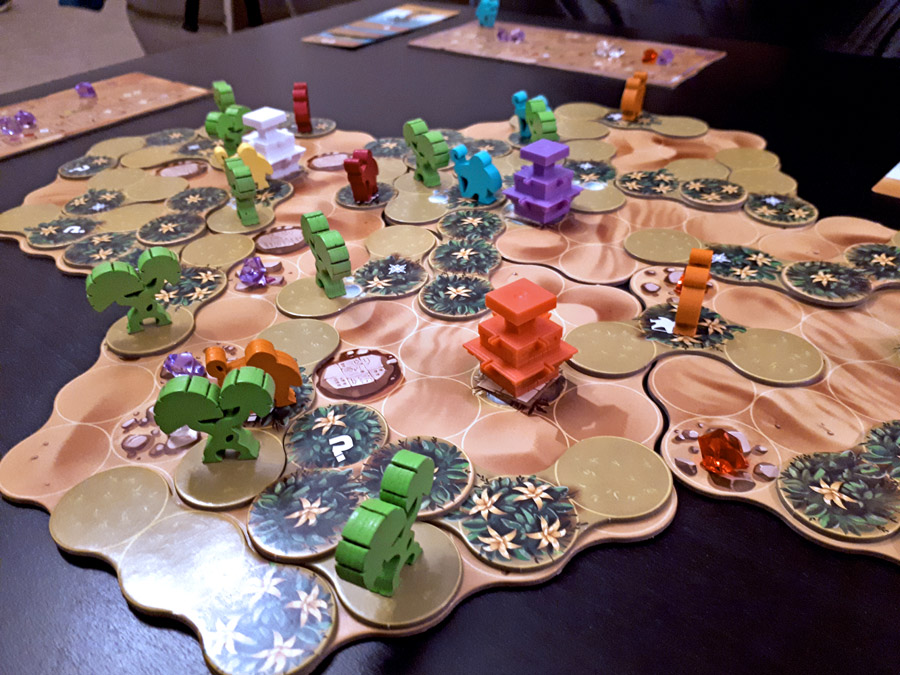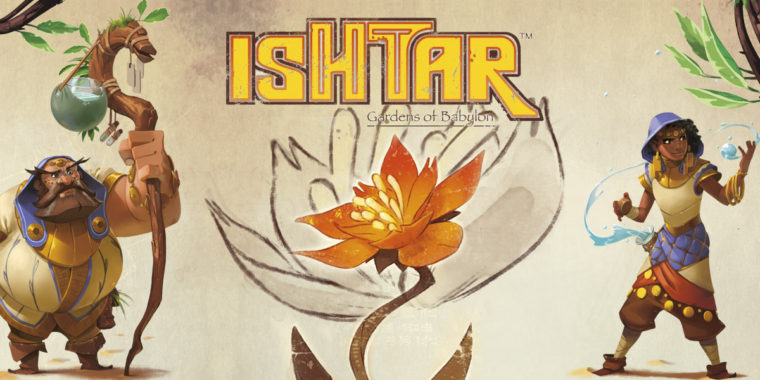It is your task to foster growth and cultivate beauty. To bring life to a barren desert, and return the Gardens of Babylon to its former glory. Are you and your apprentices up to the challenge? Or will you be buried by a superior gardener?
Ishtar: Gardens of Babylon is a tile placement and puzzle game for 2-4 players. It is designed by Bruno Cathala and Evan Singh, and published by IELLO. During the game players will place tiles, which create sections of gardens, which players can claim. Flowers in gardens, as well as trees planted and player upgrades achieved provide points, with the player amassing the most points at the end of the game winning.
There are four areas in Ishtar; the central play area, the Carpet Board, the Player Boards and the Tree Cards. The central play area contains a number of boards containing scattered crystals, and a fountain on each board. While the Carpet Board houses the Vegetation Tiles and additional Assistants.
The game revolves around placing Vegetation Tiles onto the central play area. Vegetation Tiles come in three shapes, and are placed jigsaw-like over sections of the main boards. Crystals which Vegetation Tiles cover can be claimed, and later spent on either Player Board upgrades or Tree Cards. Many Vegetation Tiles contain an additional action, allowing players to place an Assistant or pay for an upgrade.

All Vegetation Tiles cover three spaces, with each section having either flowers or grass on it. Unbroken stretches of flower sections create gardens, and these are primarily what players will be using to score. These can be claimed by players by placing Apprentice Gardeners onto them.
Tree Cards can be purchased by spending the indicated amounts of coloured crystals. The more expensive a Tree Card, the more points it is worth. Purchasing a Tree Card also allows the player to place a tree onto a grass section of the main play area. Trees block garden progress, and help players to secure sections of unclaimed gardens or impede opponent’s growth.
Player Board upgrades contain two levels of one-off effects which can be activated. The first level covers actions which help players build their gardens or resources, like taking gems or claiming additional Assistants. While the second level is available after the corresponding first level effect is used, and provides additional scoring options.
Visually the artwork is highly stylised, but in a way which creates a coherent world across multiple items. The contrast of the brown sand and stones against the vivid colours of the tiles and crystal markers is quite striking. Coupled with the Apprentice, tree and crystal playing pieces Ishtar has incredible table presence. Also of note are the Tree Card illustrations, which contain some extremely detailed (if strange) tree designs.

Each of the elements is really well made, and sturdy. The Vegetation Tiles are a good size, matching the scale of the Apprentice and tree pieces without any of the items feeling either too big or too small. The crystals are a little generic, being the same shape though coloured differently, so not completely accessible. But the game comes with a great setup and rule leaflet, and a particularly well conceived rulebook. Plus a great box insert that everything fits into nicely.
One of the designers of Ishtar: Gardens of Babylon is Bruno Cathala, so it shouldn’t really be surprising that the game is good. The main elements revolve around a solid puzzle-like mechanic of tile placement, which provides players with a thought provoking but simple core. This, when paired with the tile choice method of progressively moving around the Carpet Board and either taking or skipping the next Vegetation Tile, creates a tension between players I haven’t experienced in other games.
It is a lot of fun agonising over whether to take your current Vegetation Tile, or skip it for the next one. The real challenge rears its head as the game nears its end, and the central area begins to fill up. It becomes a tactical battle of placing tiles to maximise your own gains while diminishing the advantages you are giving established opponents.
This puzzle element is offset well by the activation of abilities via the Player Board, as well as the purchase of Tree Cards. Both supplement the main activity of growing a garden well, and give some weight to the decisions made with tile placement. Thanks to the players primary crystal source coming from the central play area.

All this allows for a surprising number of tactical approaches to be made. For instance, having the most Apprentices out claiming gardens doesn’t necessarily guarantee a win. Ishtar rewards those who think about their long term game, while also adapting their approach as circumstances change.
With the simplistic elegance of the game mechanics and visuals, the few problem areas are unfortunate and glaring. Tile placement, and garden creation, have very specific requirements which can be hard for some players to understand. And easy for new players to completely botch the implementation of. It’s all too easy for a player to place a tile illegally and no one to notice for a number of turns.
The main play area boards contain sacred tablets on some spaces. These provide additional scoring bonuses, but cannot have tiles placed over them. Simple enough, though the tablet image is confusingly similar in tone to the sand background. This makes the sacred tablets a pain to find at a quick glance, and can easily throw a players tile choice and move into disarray when they discover a previously missed tablet smack in the middle of their intended move. It doesn’t break the experience, though it does create undue frustration in a game that is already taxing at times.
Don’t let that discourage you though. Ishtar: Gardens of Babylon is a fantastic game which blends puzzle and tactical elements in a way which promotes a lot of replayability. With easy to learn rules, beautiful visuals, inoffensive player interaction and an amazing table presence, Ishtar is likely to become a huge hit with players everywhere.
Ishtar: Gardens of Babylon is available from 24 October 2019 in all good game stores or through online suppliers.




